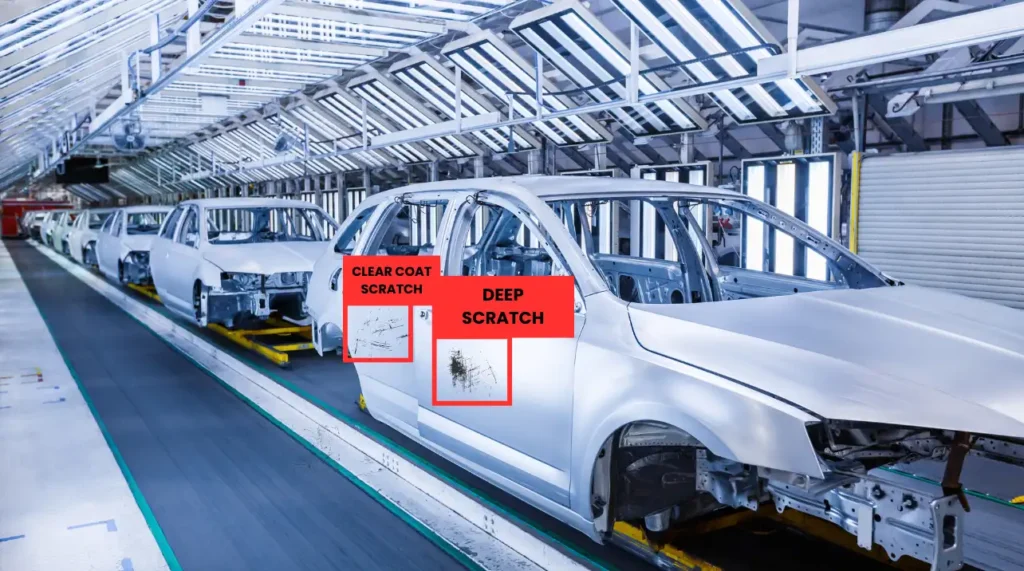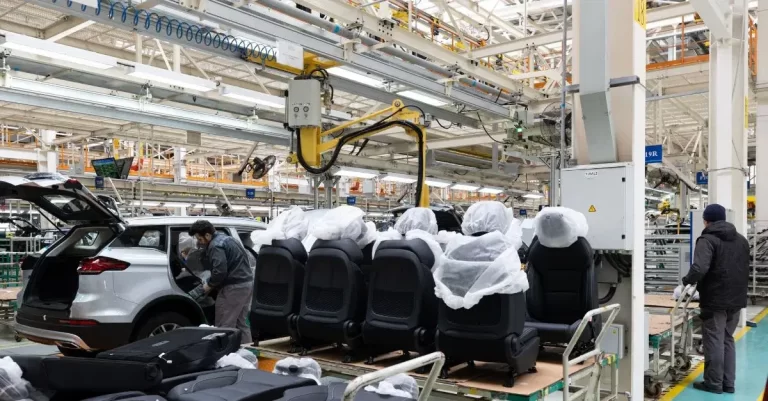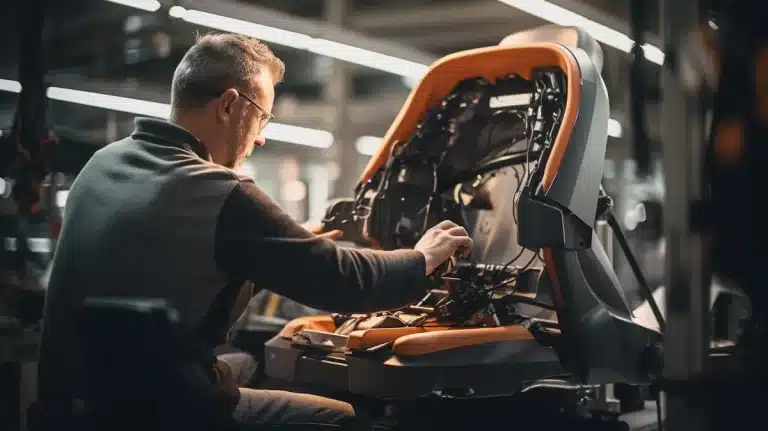Automobile Assembly Line Inspection is crucial. Every part of a car must meet strict standards for quality and safety. One small error can lead to significant safety hazards or costly recalls. In the past, manual inspection was the norm.
However, human inspections often lead to missed defects. Today, computer vision technology is changing how inspections are done.
Key Takeaways
- Small defect detection: Automated inspection systems are faster and more accurate than human inspections. They can detect defects as small as 0.5 mm.
- Advanced camera systems: Ford’s vehicle inspection systems use advanced cameras to inspect vehicle surfaces. With their methods they are able to capture defects as small as 0.3 mm. with high precision.
- Consistency & efficiency: Automobile assembly line inspection systems can work 24/7 without fatigue. They maintain consistency and reduce human error in high-volume production environments.
- Damage detection: These systems use damage detection algorithms to spot minor flaws. This reduces the risk of vehicles leaving the factory with unnoticed defects.
- Lower false positives: Advanced systems lower false positive rates. They save manufacturers time and money by only flagging genuine defects.
What is Automobile Assembly Line Inspection?
Automobile assembly line inspection is the process of checking each car part as it’s made. Each part must be flawless before it moves to the next stage.
From the engine to the body, automobile assembly line inspection with computer vision ensures everything is built to standard.
In the past, humans did most of these inspections. Now, automated systems powered by computer vision are used. These systems are faster and more accurate than human inspectors.
Challenges in Manual Inspection
Manual automobile assembly line inspections come with many problems. Workers get tired, which makes it easy to miss small defects like scratches or dents. The lighting in the factory can also affect how well workers see these flaws.
On top of that, human judgment can vary. Different inspectors might not agree on what counts as a defect. This can lead to inconsistencies in the process.
Due to these issues, manufacturers need a more reliable way to inspect cars. Automated inspection systems (AIS) solve this problem.
Automated Inspection System (AIS) Overview
The Automated Inspection System (AIS) plays a crucial role in detecting vehicle appearance defects. It consists of two main subsystems:
- Image Acquisition Subsystem (Hardware): This includes light sources, industrial cameras, lenses, slide rails, servo controllers, and motors. These components form a motion control system that moves cameras along vehicle surfaces.
- Image Processing Subsystem (Software): This part processes the captured images. It uses a vehicle model database, damage detection algorithms, and displays results. The software also controls the motors, ensuring precision in inspection.
This combination of hardware and software ensures a thorough and automated inspection of vehicle surfaces, minimizing human error.

Advantages of Automated Inspection Systems
Automated inspection systems offer several advantages over traditional human inspections. They are faster, more consistent, and less prone to error. A notable system in one study managed to inspect a vehicle in just 1 minute 50 seconds, which is approximately 6 times faster than the manual inspection time of 10–15 minutes.
Moreover, these systems can detect defects as small as 0.5 mm, which might not be visible to the human eye. In fact, experiments show that some automated systems achieve an accuracy rate of 95.6% for detecting dent defects and 97.1% for scratches.
These systems also reduce false positives, such as detecting pseudo-defects caused by lighting or surface irregularities. The high precision ensures that fewer cars are incorrectly flagged for repairs, saving manufacturers time and money.
How Computer Vision Works
Computer vision uses cameras and artificial intelligence (AI) to detect defects. These systems can inspect parts much faster and more accurately than a human. Cameras are placed along the assembly line. They capture images of each part of the car. The AI then processes these images to find any defects.
Advanced systems use multiple cameras to scan the car from different angles. For example, one design uses five cameras to capture high-resolution images. The cameras are equipped with LED lights to help see defects more clearly. This is especially useful in hard-to-see areas, like edges and corners. Automobile assembly line inspection with computer vision provides a reliable way to maintain quality.
How Defects are Detected
Cameras are placed strategically along the assembly line to capture detailed images of every part of the car. These images are then analyzed by AI algorithms. The system compares the captured images to a perfect model stored in its database.
For example, the AI checks for defects like size differences, scratches, or misaligned parts. If there’s a variation between the image and the model, the system flags the issue. This allows the manufacturer to fix the problem before it becomes serious.
Industry Examples and Success Stories
Automobile companies worldwide are adopting these systems. One such success story is a system developed by Ford, which uses high-frequency fluorescent lights and multiple cameras to inspect car bodies.
This system can detect defects as small as 0.3 mm in diameter, providing significant improvements over manual inspections. Similarly, the Mercedes-Benz factory in Spain implemented an inspection system that uses deflectometry-based techniques.
A technique used to detect tiny imperfections by measuring how light reflects off surfaces. This system inspects cars in just 30 seconds per unit, meeting the high production demands while ensuring no vehicle leaves the factory with surface defects.
Building on this success, other manufacturers have turned to automated systems to maintain high quality in more specialized areas, such as interior components like car seats.
EasyODM’s Automotive Seats Quality Control
One example of innovation in this space is EasyODM’s AI-driven automotive seat inspection solution. This solution’s system inspects seats 27 times faster than manual methods, with 30 times cost savings and a 99% defect detection accuracy.
EasyODM’s solution focuses on detecting wrinkles and surface defects in car seats, ensuring each unit meets stringent quality standards. Adopted by top automotive seat producers worldwide, this system helps manufacturers enhance both seat quality and production efficiency.
Overcoming Challenges in Defect Detection
Detecting defects on vehicle surfaces can be tricky due to lighting and reflection issues. For example, shiny surfaces can create glare, making it hard to spot defects. Different colors of cars, like black or white, may also reflect light differently, creating challenges for detection.
To overcome these problems, computer vision systems use techniques like dark-field illumination. This method helps to reduce glare and make defects stand out more clearly. Systems also use multiple lighting angles to get a better view of the surface.

Challenges in Implementing Computer Vision Systems
While computer vision offers many benefits, there are challenges. One of the biggest is cost. Setting up these systems requires high-tech cameras, software, and hardware, which can be expensive.
Another challenge is keeping the systems updated. AI algorithms need constant updates to stay effective. Manufacturers must provide fresh data so that the system can learn and identify new types of defects. If systems aren’t updated regularly, they may miss new defects.
Finally, there’s the challenge of integrating computer vision into older factories. Many manufacturers still rely on outdated equipment. Combining old systems with modern technology can be complicated and costly.
Future of Computer Vision in Automobile Assembly Line Inspection
The future of automobile assembly line inspection looks promising. As technology continues to improve, computer vision systems will become even faster, more accurate, and cost-effective. Fully automated inspection lines, with minimal human involvement, may become standard.
In addition to defect detection, computer vision could also be used for predictive maintenance. By monitoring the condition of machinery, these systems can help manufacturers perform maintenance before a machine breaks down. This can save time and money in the long run.
Conclusion
Automobile assembly line inspection is essential to ensuring the safety and quality of vehicles. Computer vision has transformed this process by making it faster, more accurate, and less prone to errors.
While challenges like cost and integration remain, the benefits far outweigh these hurdles. As technology continues to evolve, computer vision will play an even larger role in the future of car manufacturing.
Want Flawless Product Quality?
Book a free strategy call to see how AI-powered inspection can streamline your production.

Gediminas Mickus
Business Development Manager


